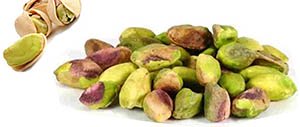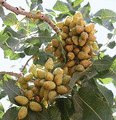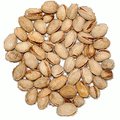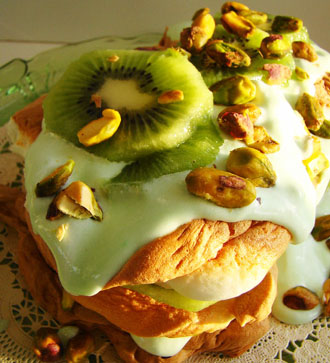Pistachio Nutrition facts
Wonderfully delicious pistachio (Pista) nuts have long been cherished as the symbol of wellness and robust health since ancient times. The kernels are enriched with many health-benefiting nutrients essential for optimum health.
Pistachio is a tree nut in the Anacardiaceae family, of the genus: Pistacia. Scientific name: Pistacia vera.
P. vera is a medium-sized, broad, bushy, deciduous tree believed to have originated in the mountain ranges of West Asia and Turkey (Anatolia). Male and female trees (dioecious) grow separately. Several cultivars exist, however, the most popular variety grown for commercial purposes is the Kerman cultivar, a native to the Kerman province of Iran from where one of the tastiest and best quality pistachios come.
 |
| Delicious Pistachio nuts! |
Pistachios grow well under hot, dry summers and cool winters. They are currently being cultivated on a larger scale in the US, Iran, Syria, Turkey, and China. After plantation, it takes approximately eight to ten years until the plant produces its first major crop. Once established, it keeps bearing fruits for many years to come.

|
| Pistachio-bunch. (Photo- bradspry) |
In a season, the pistachio tree produces a heavy cluster of fruits that appear somewhat like that of a grape bunch. The Pista fruit, in fact, is a drupe (fruit with a large, centrally located single seed), and it is this seed kernel that is actually a much sought-after "pistachio."
On its exterior, a mature fruit features a hard, off-white shell that splits open exposing a light green, oblong shape kernel inside. A pista kernel measures about 2 cm in length and 1 cm in width and weighs about 0.7-1 gm.
Health benefits of Pistachios
Pistachios are delicious tree nuts recognized for their wholesome nutritional properties. Together with walnuts, almonds, and cashew, they offer good sources of protein, fats, and minerals to inhabitants living around otherwise dry and arid regions of Central, West and South Asia.
Pistachios are a rich source of energy; 100 g of kernels carry 557 calories.
Additionally, they compose proper amounts of monounsaturated fatty acids like oleic acid and antioxidants. Regular consumption of pistachios in the diet may help lower total as well as bad LDL-cholesterol and increase good HDL-cholesterol levels in the blood.
Research studies suggest that the Mediterranean diet which is rich in dietary fiber, monounsaturated fatty acids, and antioxidants can help reduce coronary artery disease and stroke risk by favoring a healthy blood lipid profile.
Pista kernels are a rich source of many antioxidant phytochemical substances such as carotenes, vitamin E, and polyphenolic antioxidant compounds. Research studies suggest that these compounds may help remove toxic free radicals from the human body, and thus, protect it from diseases, cancers, and infections.
Pistachios are excellent sources of vitamin-E; especially rich in γ-tocopherol; compose about 23 g per100 g. Vitamin E is a potent lipid-soluble antioxidant essential for maintaining the integrity of mucosa and skin. Also, vitamin E works as a scavenger of harmful free-oxygen radicals.
The nuts are packed with many important B-complex groups of vitamins such as riboflavin, niacin, thiamin, pantothenic acid, vitamin B-6, and folates.
They are the storehouse of minerals like copper, manganese, potassium, calcium, iron, magnesium, zinc, and selenium. 100 g nuts provide 144% of the daily recommended levels of copper. Copper is an essential trace mineral that is required in neurotransmission, metabolism, as well as red blood cell (RBC) production.
Pistachio oil extracted from kernels is one of the healthiest cooking oils. It has a pleasant nutty aroma and possesses excellent emollient properties. It helps keep skin well protected from dryness. Besides being used in the kitchen, it is also employed as a “carrier or base oil” in traditional medicines in massage therapy, aromatherapy, and in the pharmaceutical and cosmetic industries.
Just a handful of pistachios a day provides enough recommended levels of phenolic antioxidants, minerals, vitamins, and protein.
| Principle | Nutrient Value | Percent of RDA |
|---|---|---|
| Energy | 557 Kcal | 29% |
| Carbohydrates | 27.97 g | 21.5% |
| Protein | 20.60 g | 37% |
| Total Fat | 44.44 g | 148% |
| Cholesterol | 0 mg | 0% |
| Dietary Fiber | 10.3g | 27% |
| Vitamins | ||
| Folates | 51 µg | 13% |
| Niacin | 1.3 mg | 8% |
| Pantothenic acid | 0.520 mg | 10% |
| Pyridoxine | 1.7 mg | 131% |
| Riboflavin | 0.160 mg | 12% |
| Thiamin | 0.870 mg | 72.5% |
| Vitamin A | 553 IU | 18% |
| Vitamin C | 5 mg | 8% |
| Vitamin E | 22.60 mg | 150% |
| Electrolytes | ||
| Sodium | 1 mg | 0% |
| Potassium | 1025 mg | 22% |
| Minerals | ||
| Calcium | 107 mg | 11% |
| Copper | 1.3 mg | 144% |
| Iron | 4.15 mg | 52% |
| Magnesium | 121 mg | 30% |
| Manganese | 1.2 mg | 52% |
| Phosphorus | 376 mg | 54% |
| Selenium | 7 µg | 13% |
| Zinc | 2.20 mg | 20% |
| Phyto-nutrients | ||
| Carotene-ß | 332 µg | -- |
| Crypto-xanthin-ß | 0 µg | -- |
| Lutein-zeaxanthin | 0 µg | -- |
Selection and storage

|
| Roasted pistachio nuts |
Pistachios can be available in the markets year-round. In the grocery stores, one may choose shelled, whole (with-shell), roasted, salted, sweetened, etc., put for sale. Try to buy unshelled (with an intact outer coat), whole nuts instead of processed ones. They are generally made available in airtight packs and bulk bins.
Look for healthy, compact, uniform, off-white, unshelled nuts that feel heavy in hand. They should be free from cracks other than the natural split, mold, spots, and rancid smell.
Raw, unshelled pistachios can be placed in a cool, dry place for many months. However, shelled kernels should be placed in an airtight container and kept in the refrigerator in order to prevent them from turning rancid.
Culinary uses
 |
| Pistachio pavlova with kiwi slices. Photo: Vegan feast catering. |
The nuts are usually eaten as they are, by splitting them open between fingers or using a nutcracker machine. They can also be enjoyed roasted, salted, or sweetened, just as in macadamia and peanuts.
Pistachios are nutty, yet pleasantly sweet in taste with a fruity aroma. Baklava, a sweet pastry made of layers of paper-thin "phyllo or strudel dough" filled with chopped pistachio, almonds, and cashew nuts and sweetened with syrup or honey, is a popular pastry preparation in Turkey, Iran, Armenia, and many Middle East states.
Roasted and crushed, its kernels can be sprinkled over salads, desserts, particularly sundaes and other ice cream-based dessert preparations (for example, kulfi in the Indian subcontinent), biscuits, sweets, and cakes.
Split pistachios are a great addition to vegetable/fruit salads.
Popularly known as "pista," these nuts have been widely used in sweet dishes in Indian, Pakistani, and other Southeast Asian countries.
Safety profile
Pistachio nut allergy sometimes occurs as allergic manifestations because of the chemical compound anacardic acid (urushiol. Cross-reactions may also occur with some other related tree nuts and fruits of Anacardiaceae family such as mango, cashew nuts, etc. Persons with known allergic reactions to these nuts may, therefore, be required to observe caution while eating cashews and mangoes, and conversely.
The reaction symptoms may range from simple skin itching (hives) to severe form anaphylactic manifestations including breathing difficulty, pain abdomen, vomiting, and diarrhea. (Medical disclaimer).
≺≺ Back to Nuts and Seeds from Pistachio nuts. Visit here for an impressive list of nuts with complete illustrations of their nutrition facts and health benefits.
≺≺ Back to Home page.
Further Resources:
Stanford School of Medicine Cancer information Page- Nutrition to Reduce Cancer Risk.
California Rare Fruit Growers- Pistacia vera. L.